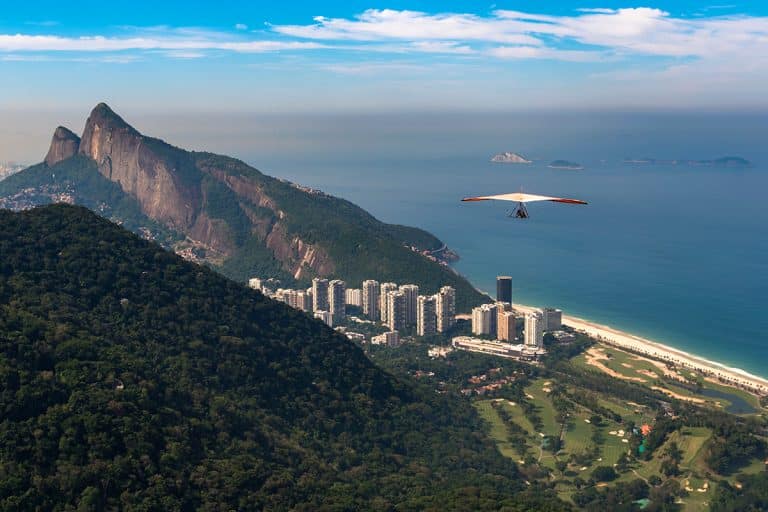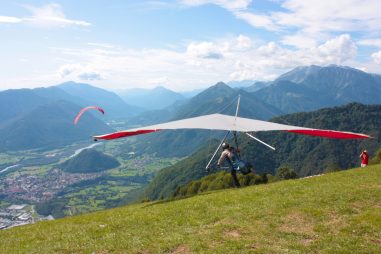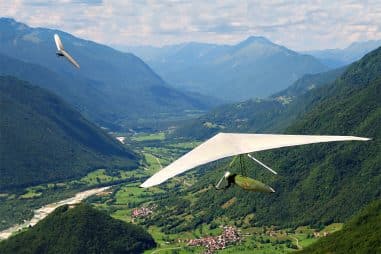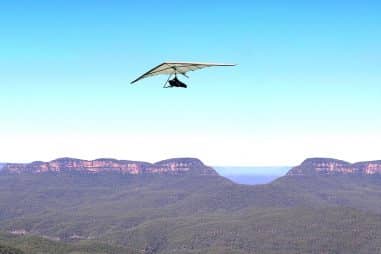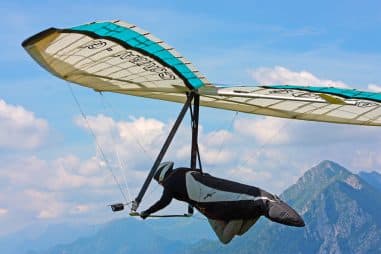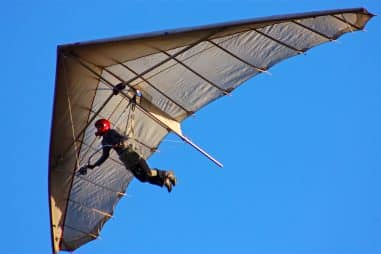The sport of hang gliding has significantly evolved throughout the years due to some major discoveries. Developments have been made to the design of hang gliders for a more fun and pleasant flying experience. If you are up for an adventure, hang gliding is a very entertaining sport that is filled with a great deal of challenges and surprises that will keep you occupied.
What Do You Do in Hang Gliding?
To simply describe what you do in hang gliding, it is the simplest kind of flying where you, the pilot, soars in the air using a nonpowered aircraft known as a hang glider. The harness attached to the frame of the glider usually hangs you in a prone position which allows you to move freely and be in control of the flight by moving your body.
It is an incredibly fun leisure activity that a lot of people take up as a hobby. On top of being able to experience what it’s like to fly freely high up in the sky, you also get to take in all the breathtaking sceneries you catch sight of from above the clouds.
Is Hang Gliding a Sport?
Hang gliding is an air sport wherein a pilot flies through the sky with the use of a lightweight aircraft without an engine called a hang glider. The pilot is usually lying face down while attached to a harness and controls the hang glider by shifting body weight. A lot of people who have experienced flying a hang glider agree that it feels like you have been changed into a bird.
Even though hang gliding is a very fun recreational activity, it is still considered an extreme sport since it involves a high degree of risk. Although this is the case, it is widely known that some dangers come with all sports and these dangers can be mitigated so long as you proceed with maximum caution. This unique sport is extremely enjoyed by a great number of thrill seekers since it provides them with a lot of adrenaline as they soar high up in the clouds thousands of feet away from the ground.
Is Hang Gliding Still Popular?
Hang gliding has massively decreased in popularity in the past couple of years. There are quite a lot of factors that led to the decline of the once widely known sport. The most common reasons are lessened exposure, increased risk of accidents, fewer manufacturers of hang gliding equipment, and fewer hang gliding schools that offer proper training.
Apart from these reasons, a new sport called “paragliding” has arisen and has been favored by a lot of people. The majority say that it’s much slower, stabler, safer easier to fly, and more comfortable. Paragliding is very similar to hang gliding, but their main difference is the pilot sits in a chair-like harness which many find very convenient because they get to set their sights on the beautiful view while flying slowly and steadily.
Where Is Hang Gliding Most Popular in the World?
There are quite a lot of places in the world where hang gliding is popular. A lot of people participate in the sport because it is an adventure sport that is challenging and packed with a lot of fun. With that said, here are some of the many locations all over the world that are worth mentioning:
- Kitty Hawk, USA, North Carolina: Kitty Hawk is extremely popular among hang gliders because this is where the Wright brothers conducted their famous flight experiments. It is undeniable that a lot of hang gliders feel a great sense of satisfaction and achievement after a good hang gliding experience where it all started. This is surely a perfect place to go hang gliding because the winds are ideal and the instructors are so knowledgeable that they can help assist those with disabilities such as blindness, deafness, and a lot more.
- Kahului, USA, Hawaii: The islands of Hawaii are a great destination for hang gliding since the weather is great most of the time and the winds are not too strong or weak. Aside from that, the sceneries you get to see are out of this world because you will be soaring above mountains, rainforests, beaches, and a lot more. Kahului is certainly worth a visit if you want to be surrounded by nature and nothing else but fresh air.
- La Jolla, USA, California: The state of California has a lot of remarkable destinations to go hang gliding but La Jolla certainly takes first place. La Jolla can be found just north of San Diego and it is well-known for its ideal weather all year round accompanied by good winds. On top of that, you will also have an amazing view of Black’s Beach as you fly in the sky which will provide you an amazing hang gliding experience.
- Queenstown, New Zealand: It is widely known that New Zealand is full of adventure which attracts plenty of people from all around the world to visit this exceedingly wonderful country. It does not come as a surprise that it is one of the best places to hang glide. Without a doubt, hang gliding is the best way to get a bird’s eye view of New Zealand’s marvelous landscapes.
- Fethiye, Turkey: The southern part of Turkey is an amazing spot not only for hang gliding but also for other wonderful activities. Fethiye has breathtaking spacious sceneries to offer as you soar through the air in the sky. Once you finish flying over the beautiful Blue Lagoon in Ölüdeniz, you will land on a beach where you can relax and enjoy the pleasant climate.
Is Hang Gliding Fun?
Whether you’re an adrenaline junkie or not, hang gliding is certainly a very fun activity! It is a great way to take some time off from the real world as you take to the skies and have a feel of what it’s like to fly freely like a bird. From setting up your glider and launching from a high platform to flying in the sky and landing properly, hang gliding has so much to offer.
Aside from being an extremely fun sport, hang gliding is also an incredibly pleasurable recreational activity that comes with a lot of challenges. If you are someone who personally loves to be challenged while having lots of fun at the same time, then hang gliding will surely fulfill your dreams and wishes.
What Are the Benefits of Hang Gliding?
Other than getting to take in a bird’s eye view of the world, hang gliding surprisingly comes with a lot of health benefits. While it does not necessarily require a lot of physical movement, hang gliding still offers you a great deal of health and fitness benefits as you make new friends that enjoy the same sport as you do. Here are some of the many health and fitness benefits that hang gliding provides you with:
- It enhances your mind: Even though it can be very easy to get distracted by the wonderful view you see from above, hang gliding requires great focus. If truth be told, hang gliding is more mentally taxing than physical. You will need to make a decent number of decisions when you’re up in the sky to avoid any kind of accident and keep yourself free from danger.
- It decreases stress levels: If you want to leave the worries of the real world behind, hang gliding is the perfect activity for you. With the wind blowing through your hair and a breathtaking view in front of you, it will be very easy to forget the struggles of everyday life. Hang gliding is super fun that will make you feel extreme happiness.
- It makes your arms and upper body stronger: Hang gliding strengthens the muscles in your arms since you’re holding onto the wing on top of you. As time passes by, your arm muscles will eventually build up. Your upper body will also grow stronger since you are suspended from a harness in a prone position for the whole duration of the flight.
What Do Hang Gliders Look Like?
Hang gliders are airfoils that are triangular in shape which are also known as a delta wing. The hang gliders we see in this day and age have been developed from Francis Rogallo’s delta wing. The new hang gliders we have today are sleeker and commonly have aluminum struts on the inner part of the fabric to give it shape.
A hang glider is a modified parachute also known as a flexible wing that is made from nylon or Dacron fabric. Through the use of aluminum tubes and cables, the triangular shape of a hang glider is kept. This design permits air to flow above the surface which in return makes its wings rise.
How Big Are Hang Gliders?
Hang Gliders come in different sizes to accommodate different types of people. Most hang gliders have a wingspan anywhere between 9 meters (30 feet) to 11 meters (36 feet) and some hang gliders are much shorter or bigger than the said measurements. As mentioned earlier, there are various hang gliders in the market for various kinds of people so always make sure to consider your weight if you are buying one for yourself.
It might also be important to remember that hang gliders made for newbies are typically bigger in square feet than hang gliders made for advanced pilots. Beginner hang gliders are normally shaped like an equilateral triangle while advanced hang gliders are shaped like an isosceles triangle. Additionally, the rear end of an advanced hang glider is much longer than the two sides of the front.
How Much Do Hang Gliders Weigh?
Its weight ranges from anywhere around 25 kg to 40 kg. The weight of hang gliders widely varies considering that there are a lot of variables that affect its heaviness such as how it was constructed, how big it is, and what materials were used to make it. Some pilots that fly hang gliders say that a good middle ground would be one that weighs 35 kg.
It is also important to note that the weight of the hang glider you will need highly depends on the weight of the pilot. A heavier pilot will require a bigger and therefore heavier hang glider so it can fly in the sky without losing height. In addition, more advanced hang gliders will always be heavier because their design is more aerodynamic which needs a stronger and heavier frame construction.
What Material Are Hang Gliders Made of?
A hang glider is typically made up of an extremely light yet strong plastic-like aluminum alloy, carbon fiber, or stainless steel airframe to create a wing, also known as the sail. The wing is usually covered with a special kind of sailcloth such as Dacron (polyethylene terephthalate), Mylar, and a lot more. An ideal hang glider should be sufficiently light to make it fly in the air but not too heavy to weigh you down.
Dacron was selected to be the standard material used after a while since it is sturdy, resistant to UV, and lasts for a long time. Mylar was used on the edge part of the sail where the glider slashes through the air because it is much smoother than Dacron which resulted in the reduced air friction. These materials used in making a hang glider will enable you to stay aloft for extended periods of time since they are extremely light all the while providing you with the highest amount of support.
Where Was the Hang Glider Invented?
The very first hang glider was made by the pioneers of practical flight in Germany. Otto Lilienthal made quite a lot of flights back that exceeded 2000 before a gliding accident in 1896 that cost him his life. He had plans of how to construct his gliders and even provided kits to be used.
In the early 1960s, people in California who were very interested in the sport were gliding down on coastal dunes with the use of delta-shaped wings they constructed by themselves. They adapted kite designs that were developed by Dr. Francis Rogallo with the help of his wife, Gertrude. The modern hang glider that we know today was born when John Dickenson fitted a Rogallo wing with a swing seat in Sydney, Australia back in 1963.
When Was Hang Gliding Invented?
Arguably, the history of hang gliding dates back to the 6th century A.D. (501-600 A.D.) wherein the people in China were tied to kites. Despite that, a significant development took place back in the 1890s when a German inventor named Otto Lilienthal made and flew the world’s first gliders in Germany which gave birth to hang gliding.
Otto Lilienthal kept notes of his experimental flights which inspired a lot of early aviation pioneers back then. After a short while, the brothers Orville and Wilbur Wright designed, built, and flew the world’s first successful powered aircraft back in 1903, and hang gliding was briefly forgotten afterward. Thankfully, the hang glider was reborn in the late 1940s when a NASA scientist named Dr. Francis Rogallo developed a flexible wing kite together with his wife Gertrude.
Who Invented Hang Gliding?
There is no definitive evidence as to who really invented hang gliding but it is notable to mention Sir George Cayley as he built and flew the world’s first model glider. He was very curious about flight which led to a lot of discoveries later on thereby inspiring and motivating other individuals that were also fascinated by flight. All through his active career, he designed different types of aircrafts such as fixed-wing machines, airships, and helicopters as well.
Another important figure who contributed a lot to the sport that we know as hang gliding today is a German inventor named Otto Lilienthal. He learned about the forces that acted on the winged flight then he started to design and construct gliders later on from information that he collected. As mentioned above, he successfully carried out over 2000 flights in at least 16 different kinds of gliders.
Why Was the Hang Glider Invented?
The hang glider was invented with the intention of making it possible for human beings to fly freely high up in the sky for long durations without falling to the ground. Hang gliders were developed for recreational purposes when pilots started to understand how to make use of air to their advantage. This enabled them to stay aloft for extended periods and fly much longer distances.
With the discoveries of numerous inventors that dedicated a great deal of their time and effort to learn about aviation in the past, we are now able to enjoy the entertaining sport of hang gliding today. Combining all the information they gathered from their countless experiments, the design of the hang glider changed dramatically for a much better and amusing flying experience.
Who Was the First Hang Glider Pilot?
The first hang glider pilot was Sir George Cayley who was an English engineer, inventor, aviator, and he is also considered a pioneer of aerial navigation and aeronautical engineering. In 1804, he successfully flew the model glider that had a wing-shaped like a kite at the front and a tailplane that was adjustable at the back. He designed the first successful glider that was capable of flying in the air while carrying a person.
Sir George Cayley was strongly interested in flight since he was a little child, and he ran different kinds of experiments intending to collect valuable information to help the design of aircraft. In 1853, he developed a bigger glider that flew across Brompton Dale in front of Wydale Hall. There is no conclusive evidence to know who flew the glider several hundred feet but there were claims that it might be Cayley’s butler, coachman, footman, or an employee named John Appleby.
Who Was Pioneer in Hang Gliding?
If you go way back into history, the Chinese were able to make kites that were big and strong enough to carry the weight of an average-sized human being at the end of the 6th century A.D. (501-600 A.D.). With that said, there were multiple early aviation pioneers that surfaced across many countries around the world throughout the 1800s. To mention a few, here is a list of several inventors that played a huge part in learning about aviation:
- Sir George Cayley – Scarborough, United Kingdom
- Otto Lilienthal – Berlin, Germany
- Lawrence Hargrave – Greenwich, England
- Percy Pilcher – Bath, United Kingdom
- John Joseph Montgomery – Yuba City, California, USA
- Octave Chanute – Paris, Kingdom of France
- Orville and Wilbur Wright (the Wright brothers) – Dayton, Ohio, USA
- Francis and Gertrude Rogallo – Sanger, California, USA
The discoveries they made inspired countless individuals that were strongly drawn to learning about aviation. There were a lot more people in the past who put in a lot of time and effort in attempting to make devices like the hang glider for the purpose of staying afloat in the sky. These inventors are just some of the many influential people that explored winged flight.
What Was the Most Important Development That Improved Hang Gliding?
Dating back to 1948, the American inventors Gertrude and Francis Rogallo made the most important development that significantly advanced the wonderful sport of hang gliding. The design of the kite they made did not have rigid supports. Instead, it relied on the wind to give it a firm shape during flight.
After a short while, Mylar was developed in the 1950s. Mylar is an incredibly light but strong plastic that is highly durable because it can be stretched for a very long time without ripping apart. The development of Mylar greatly enhanced the performance of the kite that Gertrude and Francis Rogallo designed.
What’s the Difference Between Parasailing and Hang Gliding?
The major difference between parasailing and hang gliding is that hang gliding pilots do not make use of any other equipment besides their hang glider to move through the air. Parasailing is an extremely fun leisure activity that usually involves the use of a vehicle that produces sufficient momentum to pull the parasailers. The parasailers are commonly towed by a motorboat if you want to fly over land that is connected to a uniquely manufactured parachute called a parasail.
On top of that, parasailing also includes the option to be attached to a car/jeep if the parasailers prefer to fly over land than water. Hang gliding, on the other hand, is also an incredibly enjoyable recreational activity but it solely relies on the glider and shifting of body weight while utilizing air currents to fly through the sky rather than using a vehicle to pull the pilot.

